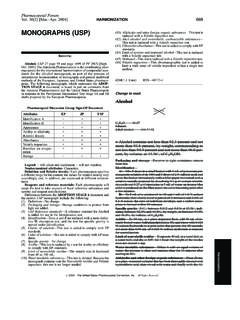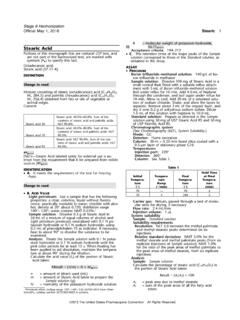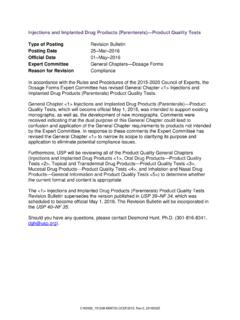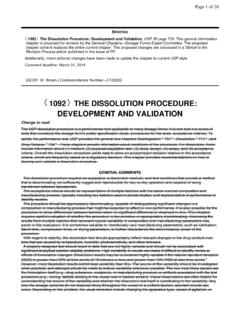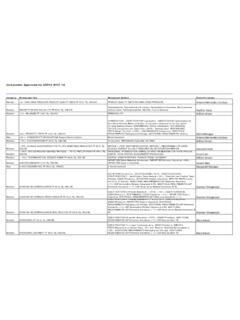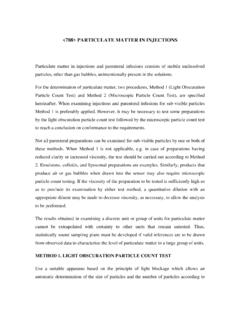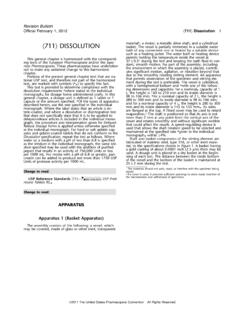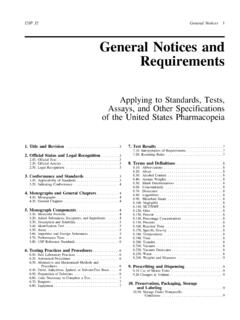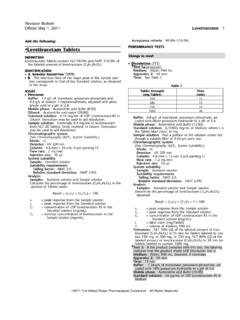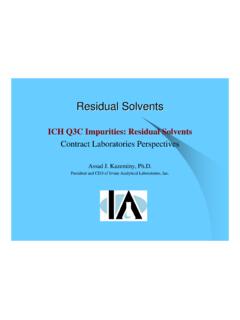Transcription of General Chapters <795> Pharmaceutical Compounding ...
1 General Chapters <795> Pharmaceutical Compounding Nonsterile Preparations Type of Posting Revision Bulletin Posting Date24 Apr 2020 Official Date01 May 2020 Expert CommitteeCompoundingReason for Revision Compliance Appeals Panel Decision In accordance with the Rules and Procedures of the 2015 2020 Council of Experts, USP is updating the status of Pharmaceutical Compounding Nonsterile Preparations <795> based on the Appeals Panel decision. The currently official <795>, last revised in 2014, remains official. On June 1, 2019, USP published revisions to General Chapter <795> for nonsterile Compounding and General Chapter <797> for sterile Compounding , as well as a new General Chapter <825> for radiopharmaceuticals.
2 After publication of the revised and new Compounding standards, USP received appeals on certain provisions in <795>, <797>, and <825>. In accordance with USP s Bylaws, the responsible Expert Committees considered the information raised in the appeals and issued decisions on the appeals (see Decisions on Appeals to USP <795> and <797> and <825>). As part of the formal USP appeals process, four (4) stakeholders who submitted appeals to the Compounding Chapters requested further review by an appointed Appeals Panel. After thoughtful deliberation and evaluation of the record and hearings from the appellants on January 21 and 22, 2020, the Appeals Panel granted the appeals to General Chapters <795> and <797> and has remanded the Chapters to the Compounding Expert Committee (CMP EC) with the recommendation for further engagement on the issues raised concerning the beyond-use date provisions.
3 The currently official <795>, last revised in 2014, remains official. The purpose of this revision bulletin is to align the display of the currently official version of the chapter in the USP-NF platform with the Appeals Panel decision. No revisions to the official text are being made. The currently official <795>, last revised in 2014, remains official. Should you have any questions, please contact the Healthcare Quality & Safety Team C262455-M99595-CMP2015, rev. 00 20200224 795 Pharmaceutical Compounding NONSTERILEPREPARATIONSAdd the following: To view the Notice that posted in conjunction with this accelerated revision, please click (RB 1-May-2020)INTRODUCTIONThe purpose of this chapter is to provide compounders with guidance on applying good Compounding practices for thepreparation of nonsterile compounded formulations for dispensing and/or administration to humans or animals.
4 Compoundingis an integral part of pharmacy practice and is essential to the provision of healthcare. This chapter and applicable monographson formulation help define good Compounding practices. Furthermore, this chapter provides General information to enhancethe compounder s ability in the Compounding facility to extemporaneously compound preparations that are of acceptablestrength, quality, and purity. Pharmacists, other healthcare professionals, and others engaged in the Compounding of drugpreparations should comply with applicable state and federal Compounding laws, regulations, and OF COMPOUNDINGIn the three General categories of nonsterile Compounding described in this section, different levels of experience, training,and physical facilities are associated with each used to determine overall classification include.
5 Degree of difficulty or complexity of the Compounding process stability information and warnings packaging and storage requirements dosage forms complexity of calculations local versus systemic biological disposition level of risk to the compounder potential for risk of harm to the Pharmaceutical Compounding Sterile Preparations 797 for risk levels associated with sterile preparations. Specialty areassuch as radiopharmaceuticals require special training and are beyond the scope of this chapter. Compounders shall acquire andmaintain knowledge and skills in all areas ( , dosage form, patient population, and medical specialty) for which of CategoriesSIMPLEM aking a preparation that has a United States Pharmacopeia (USP) Compounding monograph or that appears in a peer-reviewed journal article that contains specific quantities of all components, Compounding procedure and equipment, andstability data for that formulation with appropriate BUDs.
6 Or reconstituting or manipulating commercial products that mayrequire the addition of one or more ingredients as directed by the manufacturer. Examples include Captopril Oral Solution, Indomethacin Topical Gel, and Potassium Bromide Oral Solution, a preparation that requires special calculations or procedures (such as calibration of dosage unit mold cavities) todetermine quantities of components per preparation or per individualized dosage units; or making a preparation for whichstability data for that specific formulation are not available. Examples include Morphine Sulfate Suppositories, diphenhydraminehydrochloride troches, and mixing two or more manufactured cream products when the stability of the mixture is not a preparation that requires special training, environment, facilities, equipment, and procedures to ensure appropriatetherapeutic outcomes.
7 Examples of possible complex preparation types include transdermal dosage forms, modified-releasepreparations, and some inserts and suppositories for systemic BulletinOfficial May 1, 2020 795 1 2020 The United States Pharmacopeial Convention All Rights , rev. 00 20200224 RESPONSIBILITIES OF THE COMPOUNDERThe compounder is responsible for Compounding preparations of acceptable strength, quality, and purity and in accordancewith the prescription or medication order. The compounder is also responsible for dispensing the finished preparation, withappropriate packaging and labeling, and in compliance with the requirements established by the applicable state agencies,state boards of pharmacy, federal law, and other regulatory agencies where appropriate.
8 Individuals who are engaged in drugor dietary supplement Compounding shall be proficient in Compounding and should continually expand their compoundingknowledge by participating in seminars and/or studying appropriate literature. They shall be knowledgeable about the contentsof this chapter and should be familiar with 797 , Pharmaceutical Dosage Forms 1151 , Pharmaceutical Calculations in PharmacyPractice 1160 , Quality Assurance in Pharmaceutical Compounding 1163 , Prescription Balances and Volumetric Apparatus Used inCompounding 1176 , 1191 , Written Prescription Drug Information Guidelines 1265 , and all applicable Compounding laws,guidelines, and ensure the quality of compounded preparations.
9 Compounders shall adhere to the following General principles (additionalinformation on these General principles is provided in the sections that follow). General Principles of Compounding1. Personnel are appropriately trained and are capable of performing and qualified to perform their assigned duties. Suchtraining should be Compounding ingredients of the appropriate identity, purity, and quality are purchased from reliable sources and areproperly stored according to manufacturer specifications or USP Bulk component containers are labeled with appropriate Occupational Safety and Health Administration (OSHA) hazardcommunication labels (see ), and Material Safety Data Sheets (MSDSs)
10 Are available to compoundingpersonnel for all drugs and chemicals used in All equipment used in Compounding is clean, properly maintained, and used The Compounding environment is suitable for its intended purpose; and procedures are implemented to prevent cross-contamination, especially when Compounding with drugs ( , hazardous drugs and known allergens like penicillin)that require special Only authorized personnel are allowed in the immediate vicinity of the drug Compounding There is assurance that processes are always carried out as intended or specified and are Compounding conditions and procedures are adequate for preventing All aspects of Compounding are appropriately Adequate procedures and records exist for investigating and correcting failures or problems in Compounding , testing.
